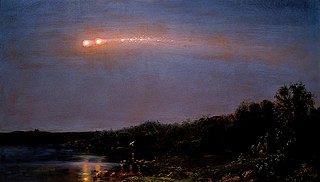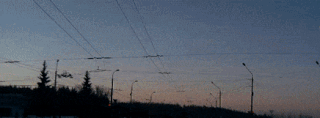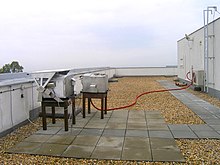
A meteorite is a solid piece of debris from an object, such as a comet, asteroid, or meteoroid, that originates in outer space and survives its passage through the atmosphere to reach the surface of a planet or moon. When the original object enters the atmosphere, various factors such as friction, pressure, and chemical interactions with the atmospheric gases cause it to heat up and radiate energy. It then becomes a meteor and forms a fireball, also known as a shooting star; astronomers call the brightest examples "bolides". Once it settles on the larger body's surface, the meteor becomes a meteorite. Meteorites vary greatly in size. For geologists, a bolide is a meteorite large enough to create an impact crater.

A meteoroid is a small rocky or metallic body in outer space.

An impact event is a collision between astronomical objects causing measurable effects. Impact events have physical consequences and have been found to regularly occur in planetary systems, though the most frequent involve asteroids, comets or meteoroids and have minimal effect. When large objects impact terrestrial planets such as the Earth, there can be significant physical and biospheric consequences, though atmospheres mitigate many surface impacts through atmospheric entry. Impact craters and structures are dominant landforms on many of the Solar System's solid objects and present the strongest empirical evidence for their frequency and scale.

The Tagish Lake meteorite fell at 16:43 UTC on 18 January 2000 in the Tagish Lake area in northwestern British Columbia, Canada.

Petrus Matheus Marie (Peter) Jenniskens is a Dutch-American astronomer and a senior research scientist at the Carl Sagan Center of the SETI Institute and at NASA Ames Research Center. He is an expert on meteor showers, and wrote the book Meteor Showers and their Parent Comets published in 2006. He is president of Commission 22 of the International Astronomical Union (2012-2015) and was chair of the Working Group on Meteor Shower Nomenclature (2006–2012) after it was first established. Asteroid 42981 Jenniskens is named in his honor.
The Great Daylight Fireball was an Earth-grazing fireball that passed within 57 kilometres of Earth's surface at 20:29 UTC on August 10, 1972. It entered Earth's atmosphere at a speed of 15 kilometres per second (9.3 mi/s) in daylight over Utah, United States and passed northwards leaving the atmosphere over Alberta, Canada. It was seen by many people and recorded on film and by space-borne sensors. An eyewitness to the event, located in Missoula, Montana, saw the object pass directly overhead and heard a double sonic boom. The smoke trail lingered in the atmosphere for several minutes.

2008 TC3 (Catalina Sky Survey temporary designation 8TA9D69) was an 80-tonne (80-long-ton; 90-short-ton), 4.1-meter (13 ft) diameter asteroid that entered Earth's atmosphere on October 7, 2008. It exploded at an estimated 37 kilometers (23 mi) above the Nubian Desert in Sudan. Some 600 meteorites, weighing a total of 10.5 kilograms (23.1 lb), were recovered; many of these belonged to a rare type known as ureilites, which contain, among other minerals, nanodiamonds.
Juraj Tóth is a Slovak astronomer, discoverer of minor planets, and professor of astronomy at Comenius University in Bratislava, Slovakia.

A meteor air burst is a type of air burst in which a meteor explodes after entering a planetary body's atmosphere. This fate leads them to be called fireballs or bolides, with the brightest air bursts known as superbolides. Such meteoroids were originally asteroids and comets of a few to several tens of meters in diameter. This separates them from the much smaller and far more common "shooting stars", that usually burn up quickly upon atmospheric entry.

Neuschwanstein was an enstatite chondrite meteorite that fell to Earth on 6 April 2002 at 22:20:18 GMT near Neuschwanstein Castle, Bavaria, at the Germany–Austria border.

On February 9, 1913, a significant meteoric phenomenon was reported from locations across Canada, northeastern United States, Bermuda, and from many ships at sea as far south as Brazil, giving a total recorded ground track of over 11,000 km, and becoming known as the Great Meteor Procession of 1913. The meteors were particularly unusual in that there was no apparent radiant, the point in the sky from which meteors usually appear to originate. The observations were analysed in detail, later the same year, by the astronomer Clarence Chant, leading him to conclude that as all accounts were positioned along a great circle arc, the source had been a small, short-lived natural satellite of the Earth.

An Earth-grazing fireball is a fireball, a very bright meteor that enters Earth’s atmosphere and leaves again. Some fragments may impact Earth as meteorites, if the meteor starts to break up or explodes in mid-air. These phenomena are then called Earth-grazing meteor processions and bolides. Famous examples of Earth-grazers are the 1972 Great Daylight Fireball and the Meteor Procession of July 20, 1860.

The Příbram meteorite fell on 7 April 1959 east of Příbram, former Czechoslovakia. Four pieces were found, the largest having a mass of 4.425 kilograms (9.76 lb).

The Chelyabinsk meteor was a superbolide that entered Earth's atmosphere over the southern Ural region in Russia on 15 February 2013 at about 09:20 YEKT. It was caused by an approximately 18 m (59 ft) diameter, 9,100-tonne (10,000-short-ton) near-Earth asteroid that entered the atmosphere at a shallow 18.3 ± 0.4 degree angle with a speed relative to Earth of 19.16 ± 0.15 kilometres per second. The light from the meteor was briefly brighter than the Sun, visible as far as 100 km (60 mi) away. It was observed in a wide area of the region and in neighbouring republics. Some eyewitnesses also reported feeling intense heat from the fireball.

On 13 October 1990, meteoroid EN131090, with an estimated mass of 44 kg, entered the Earth's atmosphere above Czechoslovakia and Poland and, after a few seconds, returned to space. Observations of such events are quite rare; this was the second recorded using scientific astronomical instruments and the first recorded from two distant positions, which enabled the calculation of several of its orbital characteristics. The encounter with Earth significantly changed its orbit and, to a smaller extent, some of its physical properties.

The Desert Fireball Network (DFN) is a network of cameras in Australia. It is designed to track meteoroids entering the atmosphere, and aid in recovering meteorites. It currently operates 50 autonomous cameras, spread across Western and South Australia, including Nullarbor plain, WA wheatbelt, and South Australian desert, covering an area of 2.5 million km2. The locations of the stations were chosen to facilitate meteorite searching. Starting in 2018, cameras deployed across the world began the first global fireball observatory in association with partner research teams.
Bunburra Rockhole is an anomalous basaltic achondritic meteorite. Originally classified as a eucrite, it was thought to belong to a group of meteorites that originated from the asteroid 4 Vesta, but has since been reclassified based on oxygen and chromium isotopic compositions. It was observed to fall on July 21, 2007, 04:43:56 local time, by the Desert Fireball Network (DFN). Two fragments weighing 150g and 174g were recovered by the DFN at 31°21.0′S, 129°11.4′E in the Nullarbor Desert region, South Australia in November of the same year. This is the first meteorite to be recovered using the Desert Fireball Network observatory.
Mason Gully is an ordinary chondrite of subclass H5, and is the second meteorite to be recovered using the Desert Fireball Network (DFN) camera observatory. One stone weighing 24.5g was observed to fall by the Desert Fireball Network observatory in Western Australia on 13 April 2010 at 10h36m10s UTC. It was recovered by the DFN on 3 November 2010 by Dr. R. Merle and the Fireball network recovery team, and was found 150m from its predicted fall location based upon the observed trajectory and calculated mass.

2018 LA, also known as ZLAF9B2, was a small Apollo near-Earth asteroid 2.6–3.8 m (9–12 ft) in mean diameter that impacted the atmosphere with small fragments reaching the Earth at roughly 16:44 UTC on 2 June 2018 near the border of Botswana and South Africa. It had been discovered only 8 hours earlier by the Mount Lemmon Survey, Arizona and based on 1+1⁄2 hours of observations, was calculated to have a roughly 85% chance of impact likely somewhere between Australia and Madagascar.

CAMS is a NASA-sponsored international project that tracks and triangulates meteors during night-time video surveillance in order to map and monitor meteor showers. Data processing is housed at the Carl Sagan Center of the SETI Institute in California, USA. Goal of CAMS is to validate the International Astronomical Union's Working List of Meteor Showers, discover new meteor showers, and predict future meteor showers.



















